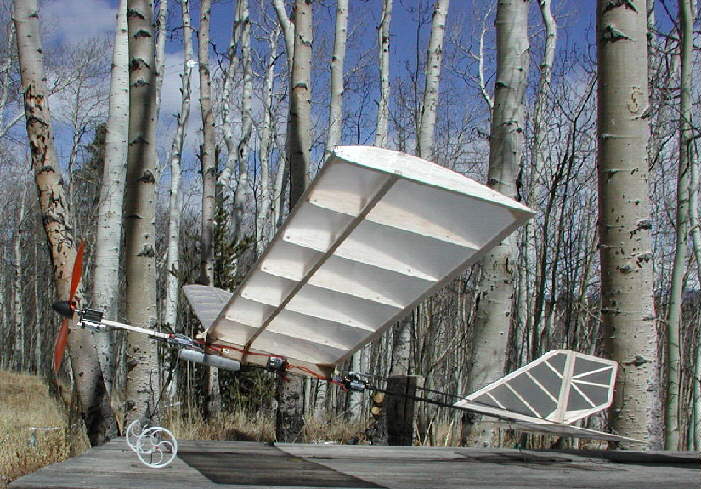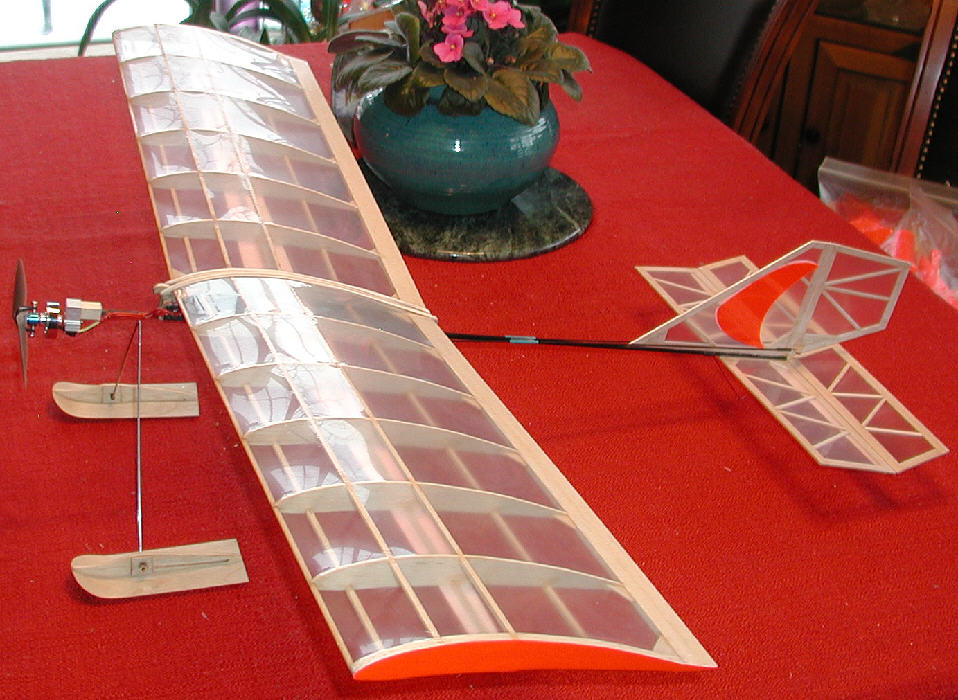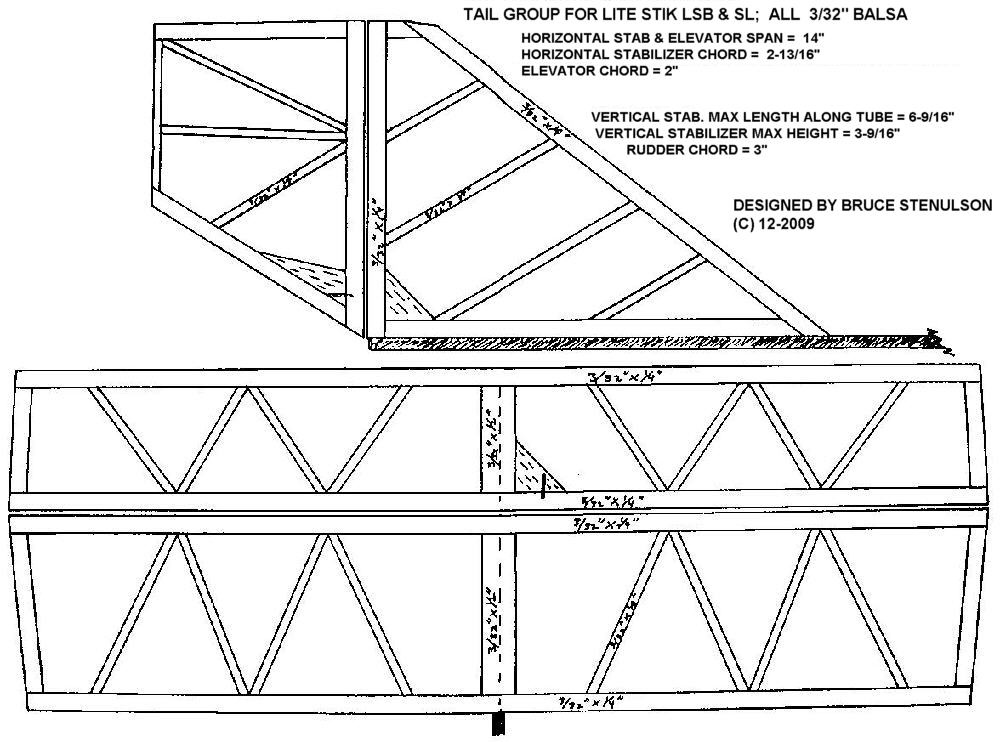

Wingspan 48 inches
Wing Area 345 square inches
Airfoil : Modified Eppler 205
Controls : Rudder & Elevator, Throttle
Flying Weight: typically 7.75 ounces when flying with an 8 cell 300mAH NiMH battery, for a wing loading of 3.25 ounces per square foot
For high altitude flying in the Central Colorado Rockies, I am now using the GWS 9x7 SF Prop and 2S Lipoly battery packs, which allows the LIGHT STIK B to easily fly at 50% to 60% of throttle.
.180 diameter Carbon Fiber tubular fuselage used; .050 solid Carbon Fiber control rods
Easy to build, easy to fly! The wing and tail group are simple to build and cover, and yet quite strong. Handling is exceptional.
UPDATE: I have a second wing built with wireing within the wing structure, and many LEDs installed for night flying. This is one of my main night flying aircraft. The E-205 airfoiled wings handle quite a bit of wind without any problems.
UPDATE: After flying with the NiMH batteries for a few years, I switched to using a 2S LiPoly battery pack.


Above: (12-07-2009 first flight): This is the Lite Stik SL. It has a 36" span built-up balsa wing which uses the NACA4408 undercambered airfoil to generate good lift at low speeds with a modest amount of input power. Flying weight is at 7-3/4 ounces with the lightweight skis mounted, and as low as 7-1/8 ounces on foam wheels when flying with a 2S 360 mAH LiPo battery. Wing area is about 2 square feet, so depending upon the battery being used, the wing loading ranges from a bit over 3-1/2 ounces, up to 3-7/8 ounces per square foot. Motor is a 24 gram brushless outrunner, 1200 Kv, turning an APC 8x3.8 prop. (Plans are not available for this design at this time.)



Above: servos, receiver, ESC, and flight battery all mount to the sides of the wing riser assembly; the Corona RS410 receiver has a modified (base loaded) short antenna setup - (The light blue wire).

Above: this is the wing rib, based on the NACA 4408 airfoil, with the 1/8" firm balsa spars added. I used a 1/4" x 1-1/2" tapered balsa trailing edge stoct narrowed down to ~7/8" wide to match the height of the tail end of the ribs. To make the ribs, I simply cut out the template, then pinned it to a stack of balsa sheets just a little larger. (I inserted pins from both sides of the stack to keep them from shifting during the shaping.) I drilled the 1/8" hole for the L.E. dowel; then I carved and sanded them to the finished shape before cutting in the notches for the spars with a fine tooth Zona saw.
]


Here's a photo of the wing riser, and the motor mount. I wanted the wing riser to be tall enough so that the servos could be mounted (simply glued) against the sides, and tall enough to mount the receiver and ESC on the left side, and to carry the flight battery on velcro on the right side. The 'balancing act' was focused then on how far forward the motor would be mounted, with the various sized 2S LiPoly battery packs being able to be adjusted in their placement to achieve final flight CG trim.
For making the wing riser, I made the two outside layers from 1/32" birch plywood, and since the fuselage C.F. tube is 5/32" O.D., 25" long. I used one 3/32" layer and one 1/16" layer of balsa to make a filler layer the same thickness as the fuselage tube. The fillers stop 5/32" above the bottom edge of the outside ply panels, so that when all is assembled, the fuselage CF tube is flush & inset between the ply side panels. There is some positive wing incicende built in the wing riser, relative to the horizontal stabilizer; I'll add the precise amount soon; I'm thinking that I am using 1.5 degrees of positive wing incidence for an efficient glide with zero to very minimal elevator trim offset.
For the motor mount, I simply drilled a ~5/32" hole into a 10mm square basswood block, and [after doing the final 'balancing act' to determine how far in front of the wing I needed the motor for everything to balance well with my assortmenty of battery sizes] the CF tube was cut off at the identified length, and the basswood block was glued in place. My final flying setup has the front of the basswood motor mount block at 2-3/4" in front of the lower front edge of the wing riser assembly. The aluminum motor mount was then installed. as shown in the photos.

Above: This is a reduced size plan of the tailgroup; dimmensions are on the image. The tailgroup is made from 3/32" balsa.
These plans and photos are made available for your personal use, for non-commercial purposes only.
I do not have the complete plans drawn out and together at this time- (it's a project that was done in bits & pieces over ~4 years); I am looking for better weather to do more test flying of the Lite Stik SL, to verify that the setup is optimized. But weather has not been good here lately- very cold, with high winds & snow storms.
But pulling together all of my drawings & sketches, and completing a full set of plans is a project that I might complete at some piont. I have now added the wing rib layout and the wing riser template to this web page. those key details, along with the photo of the tailgroup plans and a few extra dimmensions should give you enough info to build one. (You may have to draw out your own simple wing layout plan... it's easy to do on a constant chord wing. Wing rib spacing is at 3"; the wing tip ribs and the one at the center are 1/4" thick, while all of the other ten ribs are made from 1/16" balsa. Be sure to make the small triangular gussets for where each rib butts against the tapered trailing edge- this really strengthens this vulnerable area of each rib very nicely.
I built the wing structure itself about four years ago, then set it aside... (I may have built well over 20 new designs since then.) I finally covered the SL wing last winter, and then finally came back to this project recently to complete the aircraft and do the first test flight. (At only 14 degrees, the LiPoly 2S 460 battery became critically chilled within ~5 minutes, and so I postponed further flying for a friendlier day. )
For even faster turning response, the dihedral angle on the SL wing could be increased beyond what I built into the prototype wing; but the handling is smooth & predictable, and the glide may be a bit more efficient with the lower dihedral angle. The SL was designed to be a mellow slow flyer which would be very relaxing to fly and require modest input power. (For indoor flying in smaller spaces, the higher dihedral might be advantageous... but I fly outtdoors 99.9% of the time, and so I chose to build it this way. I wasn't designing as a hyperlight aircraft; I wanted one which would take off and land in the outdoor environment, be tough enough to be durable and resilient, and have enough power to deal with light winds reasonably.
I wanted a ~1200Kv motor, to turn a larger diameter low-pitched prop, for more efficient slowc flying... the smaller lighter motors would have plenty of power, but are all higher Kv, & so I chose the 1200Kv 24 gram motor. The balance works out well as laid out- everything from the servos to the flight battery all mount on the wing riser.
The tail group is identical to that which I origionally designed for the Lite Stik B many years ago. I actually produced a limited run of kits for that design, with full size printed plans and a color photo illustrated build guide. (It's been out of production for quite a while now.)
BALANCE / CG FOR THE NACA4408 AIRFOIL WING FOR THE LITE STIK SL IS ON THE MAIN PAIR OF WING SPARS LOCATED ABOVE / BELOW EACH OTHER AT 3-1/8" BACK FROM THE LEADING EDGE, WHICH IS AT ABOUT 38.5% OF CHORD.
More later UPDATE NOTE: during power off gliding, the windmilling fixed prop does generate a lot of drag. To minimize this, I mounted a 8x4 folding prop set which I purchased from BP Hobbies.
Wingspan: 35-3/4" projected span
Wing Chord: 8-1/8"
Wing Area: ~295 square Inches = 2.05 Square Feet
Weight without battery, minimum: 6-1/8 ounces
Flying Weight : From 6-7/8 oz with light wheels & 2S 360, up to 7-3/4 oz. with 2S 800 and skis mounted
Wing Loading : From 3.35 to 3.9 Ounces per square foot
Overall Length: 29-3/4"
Materials Of Construction: Balsa for wing and tailgroup structure; 1/8" hardwood dowel for the wing's leading edge
.157" / 4mm O.D. CF tube for fuselage shaft
1.5mm CF rods used for elevator and rudder control rods
Motor Used: 2712 1200Kv "24 gram Blue Wonder" type Brushless Outrunner
ESC : Turnigy Plush 10 Amp (programmable)
Battery: 2S 360mAH, 2S 460mAH, to 2S 900 mAH LiPoly
Propeller: APC 8x3.8 slowflyer prop (or 8x4 folding prop)
Radio Receiver: Corona RS410 4 Channel Single Conversion, with modified base loaded short antenna
Transmitter Used: Airtronics Radiant FM
Servos: two HXT500 5 gram servos for Rudder and Elevator